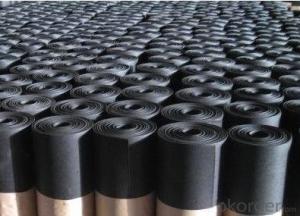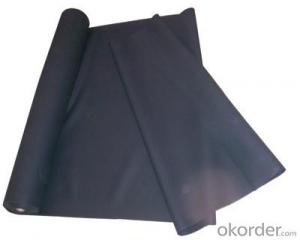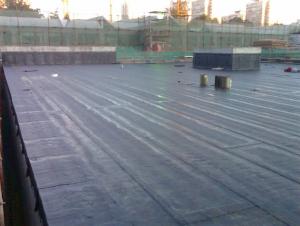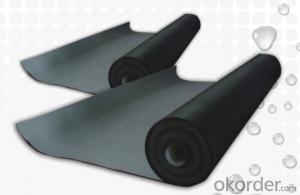EPDM Coiled Rubber Waterproof Membrane with 1.5mm Thickness
- Loading Port:
- Shanghai
- Payment Terms:
- TT OR LC
- Min Order Qty:
- 20000 m²
- Supply Capability:
- 5000000 m²/month
OKorder Service Pledge
OKorder Financial Service
You Might Also Like
EPDM Coiled Rubber Waterproof Membrane with 1.5mm Thickness
Description Of EPDM Coiled Rubber Waterproof Membrane with 1.5mm Thickness:
This waterproof coiled material is of high elasticity with best performance among high polumer
waterproof coiled material in the world.It is also the most typical one in the world.Waterproof coiled material made of ternary ethylene-propylene rubber is produced withthe use of the most advanced contiuous extrusion and vulcanization technology and related equipments which are specially designed for production of such product.It is good in compactness,without bubble and performance difference in length and breadth,perfomances reach or exceedthe demands of GB18173.1-2000 standard.
Main Features of EPDM Coiled Rubber Waterproof Membrane with 1.5mm Thickness:
A.Polyester based SBS Modified Bitumen Waterproofing Membrane
a. Strong impermeability
b. High tensile strength, elongation, ability to adapt the grassroots shrinkage deformation and cracking
c. Puncture-resistant, broken resistant, tear-resistant
d. The corrosion resistance, resistance to mildew, weathering good
e. Construction convenient, hot-melt can be operated Four Seasons Construction, reliable joints
B. Fiberglass based SBS Modified Bitumen Waterproofing Membrane
a. High tensile strength, stability of a good size
b. High Temperature good performance
c. Damage resistance, corrosion resistance, resistance to mildew, weathering good performance
d. Good construction performance, reliable joints.
Specifications of EPDM Coiled Rubber Waterproof Membrane with 1.5mm Thickness:
| Material | EPDM Rubber |
| Size | 1.2m (width)*20m (length) or customized, weldable type 2.05m or 4m width |
| Thick | 1.2mm, 1.5mm, 2.0mm |
| Type | Vulcanized & Weldable |
| Pattern | Non-reinforced (homogeneous) |
| Certificate | ISO9001/14001 |
Applications of EPDM Coiled Rubber Waterproof Membrane with 1.5mm Thickness:
1. Roofs, Basement, Toilet
2. Industrial and civil building waterproofing
3. Geo-synthetic liner for swimming pool, channels, irrigation system
4. Especially suit for projects with high requirements in durability, anti-corrosion and deformation

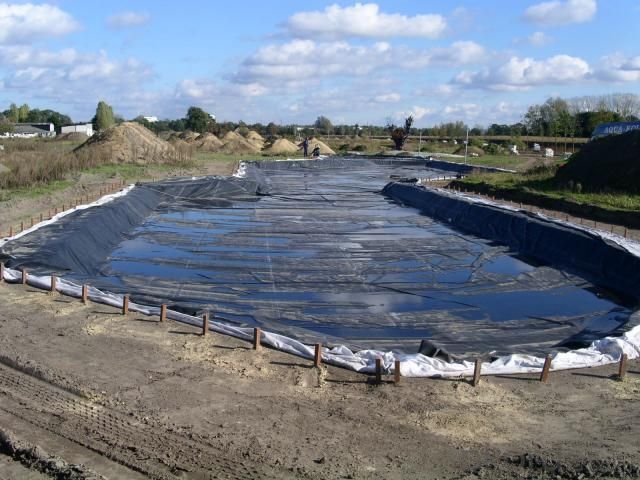

IMages of EPDM Coiled Rubber Waterproof Membrane with 1.5mm Thickness:




FAQ of EPDM Coiled Rubber Waterproof Membrane with 1.5mm Thickness:
1. What are we supplying?
We are specialized in producing Colorful Asphalt Roof Shingle, SBS/APP modified bitumen waterproof membrane, Self adhesive bitumen waterproof membrane, PVC waterproofing membrane, EPDM rubber roofing membrane, Single Component Polyurethane Waterproof Coating, and Spray Polyurea Waterproof Coating
.
2. How Many years experience do we have?
We have been exported to more than 20 countries in the past 15 years.
3. How long do we usually reply your request?
We always reply our customer within 24 hours.
- Q:Can a waterproofing membrane be used in areas with chemical exposure?
- Yes, a waterproofing membrane can be used in areas with chemical exposure. However, it is important to select a waterproofing membrane that is specifically designed to withstand chemical exposure. Not all waterproofing membranes are created equal, and some may not be suitable for use in areas with chemical exposure. Chemical-resistant waterproofing membranes are typically made from materials such as polyurethane, epoxy, or polyurea, which are known for their resistance to various chemicals. These membranes are designed to provide a protective barrier against moisture and chemicals, preventing them from seeping into the underlying surfaces. When choosing a waterproofing membrane for areas with chemical exposure, it is crucial to consider the specific chemicals that will be present. Different chemicals can have different effects on materials, so it is essential to select a membrane that is specifically designed to resist the chemicals in the environment. Consulting with a professional or manufacturer is recommended to ensure the appropriate selection of a chemical-resistant waterproofing membrane for the specific application.
- Q:Are waterproofing membranes resistant to alkali exposure?
- Yes, waterproofing membranes are typically resistant to alkali exposure. These membranes are designed to provide a protective barrier against water and other harmful substances, including alkalis. They are made from materials such as rubber, bitumen, or polymer-based compounds that have a high resistance to alkali. This ensures that the membrane remains intact and effective even when exposed to alkali-rich environments, such as concrete or cement surfaces. Additionally, these membranes undergo rigorous testing and are specifically manufactured to withstand alkali exposure, making them a reliable solution for waterproofing applications in various industries, including construction and infrastructure.
- Q:Pvc waterproof membrane of the scope of application
- 6, light color of the surface reflection of ultraviolet radiation, the surface of the membrane to absorb less heat, low temperature; 7, long life (roof 25 years, more than 50 years underground), and no environmental pollution; 8, the details of processing is very convenient, easy maintenance, low cost.
- Q:Are there any drawbacks or limitations to using a waterproofing membrane?
- Yes, there are some drawbacks and limitations to using a waterproofing membrane. One limitation is that the installation process can be time-consuming and labor-intensive. Waterproofing membranes often require careful surface preparation and multiple layers, which can be time-consuming and may require skilled labor. This can increase the overall cost of the project. Another limitation is that waterproofing membranes may not be suitable for all surfaces. Some membranes are designed specifically for certain types of substrates, such as concrete or metal, and may not adhere properly to other materials. It is important to select the appropriate type of membrane for the specific surface to ensure proper adhesion and effectiveness. Additionally, waterproofing membranes can be sensitive to environmental conditions. Extreme temperature fluctuations, UV exposure, and chemical exposure can degrade the membrane over time, reducing its effectiveness. Regular inspections and maintenance may be required to ensure the longevity of the membrane. Furthermore, waterproofing membranes can be susceptible to damage during installation or from external factors such as foot traffic or heavy objects. Punctures, tears, or improper installation can compromise the integrity of the membrane and reduce its ability to prevent water infiltration. Lastly, waterproofing membranes may not completely prevent water penetration in certain situations. For example, if there are existing cracks or structural issues in the substrate, water may still find a way to seep through, bypassing the membrane. It is important to address any underlying structural issues before applying the membrane to ensure optimal performance. Overall, while waterproofing membranes offer many benefits in terms of protecting against water damage, it is crucial to consider these limitations and drawbacks to make an informed decision about their use in specific applications.
- Q:Can a waterproofing membrane be used for a school building foundation?
- Yes, a waterproofing membrane can be used for a school building foundation. Waterproofing membranes are designed to prevent water infiltration into structures, and they are commonly used in various construction applications, including building foundations. By installing a waterproofing membrane on the foundation walls, it can help to protect the building from water damage and prevent moisture-related issues such as mold, deterioration, and structural damage. This is particularly important for school buildings, as they often have extensive foundations and are subject to heavy usage and potential water exposure. Therefore, using a waterproofing membrane can be an effective solution to ensure the longevity and structural integrity of the school building foundation.
- Q:Can a waterproofing membrane withstand heavy rain or water pressure?
- Yes, a waterproofing membrane is designed to withstand heavy rain and high water pressure. It is specifically engineered to create a barrier that prevents water from penetrating through, ensuring the protection and integrity of the underlying structure.
- Q:Are waterproofing membranes flexible?
- Yes, waterproofing membranes are typically flexible. They are designed to be pliable so that they can conform to the shape and movement of the surfaces they are applied to. This flexibility allows the membranes to effectively seal gaps, cracks, and joints, preventing water from infiltrating into the underlying structure. Furthermore, the flexibility of waterproofing membranes also enables them to withstand the expansion and contraction that occurs due to temperature changes or structural movements. Overall, the flexibility of waterproofing membranes is a crucial characteristic that ensures their durability and effectiveness in protecting structures from water damage.
- Q:Can a waterproofing membrane be used on steel surfaces?
- Indeed, steel surfaces can benefit from the application of a waterproofing membrane. These membranes are specifically designed to establish a shield against moisture and water incursion, and they possess the versatility to be utilized on a range of surfaces, including steel. Construction endeavors, including roofs, balconies, and foundations, frequently feature steel surfaces. By employing a waterproofing membrane on these steel surfaces, one can effectively thwart corrosion and harm arising from water contact. It is crucial to carefully choose a waterproofing membrane that suits steel surfaces, while also adhering to correct surface preparation and application techniques to attain maximum performance and longevity.
- Q:Can a waterproofing membrane be used on precast plastic surfaces?
- Yes, a waterproofing membrane can be used on precast plastic surfaces. These membranes are designed to be versatile and can be applied to a variety of materials, including plastic. They provide an effective barrier against water penetration and help protect the underlying surface from moisture damage.
- Q:Can a waterproofing membrane be used on swimming pool decks?
- Yes, a waterproofing membrane can be used on swimming pool decks. Waterproofing membranes are designed to create a barrier against water penetration, making them ideal for protecting areas exposed to moisture, such as swimming pool decks. These membranes are typically applied to the surface of the deck, forming a seamless and durable waterproof layer. This helps prevent water from seeping into the deck, avoiding potential damage caused by moisture, such as cracking, mold growth, or structural deterioration. Additionally, waterproofing membranes can also provide added benefits, such as increasing the lifespan of the deck and improving its overall appearance.
1. Manufacturer Overview |
|
|---|---|
| Location | |
| Year Established | |
| Annual Output Value | |
| Main Markets | |
| Company Certifications | |
2. Manufacturer Certificates |
|
|---|---|
| a) Certification Name | |
| Range | |
| Reference | |
| Validity Period | |
3. Manufacturer Capability |
|
|---|---|
| a)Trade Capacity | |
| Nearest Port | |
| Export Percentage | |
| No.of Employees in Trade Department | |
| Language Spoken: | |
| b)Factory Information | |
| Factory Size: | |
| No. of Production Lines | |
| Contract Manufacturing | |
| Product Price Range | |
Send your message to us
EPDM Coiled Rubber Waterproof Membrane with 1.5mm Thickness
- Loading Port:
- Shanghai
- Payment Terms:
- TT OR LC
- Min Order Qty:
- 20000 m²
- Supply Capability:
- 5000000 m²/month
OKorder Service Pledge
OKorder Financial Service
Similar products
New products
Hot products
Related keywords

